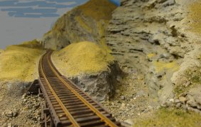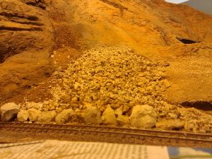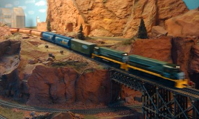TOWER MOUNTAIN - a Look from the Past to the Present
|
in deutsch  |
|
(Mausklick zum Vergrössern der Bilder) | |
| Preface |
|
Unfortunately, very few applicable historical notes were available to support any research for the area of interest. The long defunct Red Rock Sentinel provided – besides obituaries and social news – very scarce clues on the importance of the area’s rail development and traffic. So, some of the author’s views may appear to be closer to fiction than reality. Nonetheless, hopefully a good read – and a good story is always worth to be told. |
 |
| This rough sketch shows the simplified geographical relations of the railroad lines under scrutiny. The trackage belongs to the Red Rock Canyon Railroad (RRCRR), which does not actually operate its own rolling stock. The track usage is leased to whoever has a need for it. Nanninga Creek (pronounced Naaan-in-ga) is really a place in the nowhere. Flat, with no attractive landmarks (except for the far away Tower Mountain range) and hardly any population, presently it is just an interchange with the rail lines of the various major railroad companies. But there is more to Nanninga Creek, a place that probably saw better times during the heydays of steam engines, prospecting, mining, gold digging and logging. |
 | A railroad repair and servicing facility is in operation. The remarkably grand roundhouse (with a still functional turntable) is undergoing major renovation work. The RRCRR historical society is attempting to revitalize the area, bringing back steam to the entire RRCRR system. At the moment there is just one old-timer located at Red Rock South in open air storage. This effort certainly will become appealing to the tourist industry – steam in the Red Rocks! |
| The original RRCRR line leaves Nanninga with multiple tracks due west, squeezing through the ‘Gap’ south of Tower Mountain to reach the Fraser creek.
Here you see the original track, recently reopened after a major rock fall, through the Fraser Creek. It leads to the southern Red Rock Canyon area with its old, now defunct, coal mining industry. Although several times improved, it still is a long winded run along the Fraser creek ridge and around and along the southern Red Rock foothills. |
 |
 |
One attempt to improve the situation altogether, was the rather costly tunneling along the Fraser Creek ridge through sediment rock in parallel to the existing winding track in the creek – extended even to double track as shown. Sadly enough though, newer freight cars used
for the aerospace industry require more side clearance than the southern tunnel exit seen here is able to offer. Therefore, until the concrete shed structure has been reworked, the old track through the creek must be used for wide-load exception trains.
The tracks seen here will lead either to the east to Nanninga, or west (passing Tower Mountain) to northern Red Rock. |
| Much earlier, in the last century, a discovery was made which should provide the base for a new route to the northern Red Rock area in the far future – and this by sheer coincidence by a foreign exploration company. |
 On the slope of Tower Mountain prospectors found promising traces of Erbium, a rare earth sought after by scientists around the world. The first rocks were found in the small rock slide besides the original rail line leading from the Nanninga area to the Fraser Creek. Unfortunately however, the traces were
located at the east side of Tower
Mountain only.
On the slope of Tower Mountain prospectors found promising traces of Erbium, a rare earth sought after by scientists around the world. The first rocks were found in the small rock slide besides the original rail line leading from the Nanninga area to the Fraser Creek. Unfortunately however, the traces were
located at the east side of Tower
Mountain only.
Unfortunate
because the west side of the
Tower Mountain had already
been made accessible by a rail
line extended from Fraser Creek
to the far north of Red Rock. However, this line was plagued by repeated rock slides from the Tower Mountain until it’s rebuilding to double track and securing against the mountain as it stands today shown at the left.
|
| The end of WW1 promised a soon booming economy. Therefore also the directors of the Canadian Hudson Bay Company got interested in that Erbium discovery. To gain the rights for exploitation of this rare earth a subsidiary, HBC of America Inc., was swiftly founded.
A temporary track was laid from Nanninga on a high line towards the eastern slope of Tower Mountain. To get there, a short tunnel had to be driven through a peculiar rock outcropping called Devil’s Nose to get to the slope.
The instability of the rock in the devil’s nose made a concrete reinforcement of the tunnel entrances necessary. |
 |
| As it is the case with so many promising endeavors, accidents delayed the exploration over and over again, and finally the consequential yield did not impress the investors at all. WW2 was looming at the horizon. With several co-investors withdrawing their support, the exploration was consequentially discontinued and the site finally abandoned. |
 |
 | The left-over was the right of way from Nanninga, the tunnel through the Devil’s Nose and a cavern into Tower Mountain. After WW2 a review showed that the Erbium extraction would never pay off the investments still needed, as Erbium became available from other sources at an unbeatable low cost.
At the left you see today’s appearance of the secured rock slide area where Erbium was found first near the Tower Mountain Gap, leading to the activities by the Canadian Hudson Bay Company. |
| With post-war rise in economy the commercial need
became stronger to improve the freight traffic to and from
the northern Red Rock industrial area. And indeed, several
railroad companies saw the commercial advantage of a
passage through the Tower Mountain, reducing the travel
distance to northern Red Rock by 80%. The Red Rock
Canyon Railroad management was approached and the
necessary funds secured through private investors. The old
exploration site brought to life saw the completion of what
is known today as the Tower Mountain tunnel in record time
- a cutoff to the previous long winded trackage through the Fraser Creek. |
 |
| Today, quite often loaded trains arrive in Red Rock north from Nanninga via this new Tower Mountain tunnel, and leave empty on the southern route via Red Rock south, either through the Fraser Creek tunnel or via the old line in the creek back to Nanninga and homewards. Here you see, no coincidence, an empty British Columbia Railway grain train leaving the grain elevators and heading back for Canada. |
 |





 On the slope of Tower Mountain prospectors found promising traces of Erbium, a rare earth sought after by scientists around the world. The first rocks were found in the small rock slide besides the original rail line leading from the Nanninga area to the Fraser Creek. Unfortunately however, the traces were
located at the east side of Tower
Mountain only.
On the slope of Tower Mountain prospectors found promising traces of Erbium, a rare earth sought after by scientists around the world. The first rocks were found in the small rock slide besides the original rail line leading from the Nanninga area to the Fraser Creek. Unfortunately however, the traces were
located at the east side of Tower
Mountain only. 






